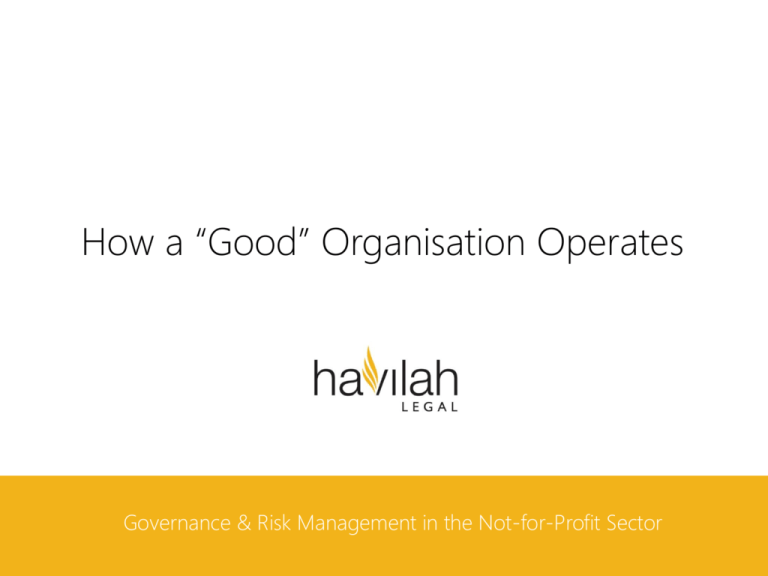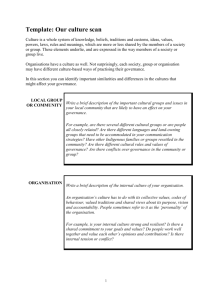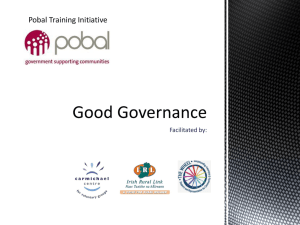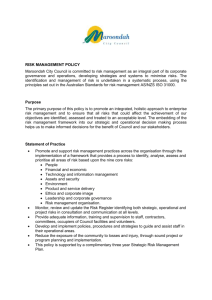NFP Seminar 180815
advertisement

How a “Good” Organisation Operates Governance & Risk Management in the Not-for-Profit Sector Introduction • Bruce Havilah – Principal, Havilah Legal • Panel Members – Craig D’Souza – Sean Somerville Disclaimer • Please note that this presentation and its contents has been prepared for general information purposes only and is not intended to constitute legal advice nor should it be relied upon as such. • You should consult with a lawyer in relation to any legal advice you require, especially in respect to any specific issues or questions which may arise. Governance Framework What is ‘Governance’? • Governance encompasses the system by which an organisation is controlled and operates, and the mechanisms by which it, and its people, are held to account. Ethics, risk management, compliance and administration are all elements of governance. • Governance incorporates the disciplines of management, finance, accounting and law, however it is the legal aspect that is perhaps most important from a compliance perspective. • Those involved in corporate governance must have an understanding of the legal system in which an organisation operates. • Many core governance principles are embedded in or arise from common law and statutory obligations. Practical Steps for Implementing Structure • Strategic planning – what is the vision and how do we get there? • Values and Behaviours – how does the organisation relate both internally and externally from the top to the bottom? • Policies and Processes – where can you capitalise on the efficiencies and where is there waste? • Risk Management – how does our due diligence identify and avoid or minimise any potential risks? Principles of Good Governance • Eight ASX governance principles: – Lay solid foundations for management and oversight – Structure the board to add value – Promote ethical and responsible decision-making – Safeguard integrity in financial reporting – Make timely and balanced disclosure – Respect the rights of shareholders – Recognise and manage risk – Remunerate fairly and responsibly http://www.asx.com.au/documents/asx-compliance/cgc-charter.pdf Legal Framework: Regulation and Compliance Source of Law and Legal Obligations • Compliance with legal obligations is a key aspect of good governance • Legal obligations and duties arise under: – Statutes and subsidiary legislation – Common law – Equity Regulation and Compliance • Different kinds of entities have different regulation • An organisation's entity type will have a bearing on the statutory compliance required • Legal requirements shape what is necessarily required by way of good governance Common NFP Legal Structures • Company limited by guarantee – Corporations Act 2001 (Cth) • Incorporated association – Associations Incorporation Act 1987 (WA) – Equivalent state legislation for those incorporated outside WA • Unincorporated association • Other bodies corporate – Incorporated by royal charter (i.e. Chartered Accountants Australia New Zealand, Governance Institute) – Incorporated by specific legislation (e.g. Scout Association Act 1932 (Vic)) Regulation of Companies • The regulation and legal controls underpinning a company and its officers principally arise under the corporations law. • CLERP and Simpler Regulatory System reforms have reformed corporations law. • Corporations law is now embodied in the Corporations Act 2001 (Cth) • Significant regulatory burdens under Act Other Key Legal Considerations • Governance Related Law that should be considered: – Taxation (rights/obligations) – Employer obligations • • • • • – – – – – – (e.g. Fair Work) Awards Discrimination Work place safety Professional development Trade Practices – avoid misleading Environmental protection Privacy Tort law Intellectual property Volunteer obligations and liability Corporate Constitution • Organisations are principally governed in accordance with the relevant regulatory statute and any constitution • s 134 Corporations Act 2001 (Cth) states that the internal management of the company is governed by a constitution. • s 9 Associations Incorporations Act 1987 (WA) requires a constitution (rules) to be lodged with the application to incorporate. Managing Governance Obligations Two key strategies: 1. Due Diligence • A means to monitor an organisation’s process of evaluation. • A way of verifying that an organisation is meeting its broader compliance objectives. • In carrying out its internal due diligence an organisation will conduct a legal risk audit, from which compliance plans will be developed. 2. Compliance Programs – • AS 3806 highlights the role of the compliance program within both due diligence and corporate governance. Financial Management Financial Management • Compliance and accountability – Financial reporting – Tax obligations (GST, FBT etc) – Staying up to date with reforms • Requisite skill set for directors and officers Sean Somerville CPA – Somerville Advisory Group Directors’ Duties Directors – Who Are They? • Company limited by guarantee – Directors and officers are the persons principally charged with the running of a company – s 201A • Public companies must appoint a minimum of three directors (at least two must ordinarily reside in Australia) –s9 • Courts will generally look at the function of the person, rather than their formal appointment or job title to ascertain who is a director Who Are the Board or Committee Members of an Association? • The committee of an incorporated association comprises: – those persons who have the power to manage the affairs of the association under the rules of the association (also known as the “constitution”) (see s 20) • A member of the committee is also known under the Act as an "officer" (see s 3). An association is required to maintain a record of all committee members (see s 29) • Committee members are not generally personally liable for the debts and liabilities of the association (see s 12) • Committee members ("officers") have an obligation to ensure the association complies with its obligations under the Act (see s 42) Directors’ Duties Directors’ Duties • For Companies – s 180 Corporations Act 2001 (Cth): Duty to exercise due care, skill and diligence • – – – – The defence is based on reasonableness (the business judgment rule) s 181: Duty to act in good faith and for a proper purpose s 182: Prohibition against improper use of the position s 183: Prohibition against improperly using information s 184: Duty to avoid conflicts of interest and to act honestly ACNC – Governance Standard 5, replaces most of the requirements under the Corporations Act for responsible persons of a Charity. Directors’ Duties Cont. • Associations (statute) – s 21: Disclosure of pecuniary interests – s 22: Not deliberating on a contract in which you have a pecuniary interest • Common Law/Equity Duty to act with reasonable care and due diligence Duty to retain discretions Duty to avoid conflicts of interest Duty to act in good faith in the interest of the company – Duty to use powers for a proper purpose – – – – Risk Management and Accountability The Aim of Risk Management • To identify, measure, allocate responsibility and monitor the exposure to risks of any activity • Focus attention on key risks but don’t forget "the weakest link" Relationship of Risk Management to Fraud in the NFP Sector • Risk of fraud in NFPs – lack of controls • BDO – Not-for-profit Fraud Survey 2014 • Fraud can cause serious reputational damage in NFP • Proper risk management involves accountability • Addressing risk within organisational process can lead to competitive advantage in the marketplace, providing strategic uplift in addition to meeting compliance objectives or requirements Four Step Process 1. Identify the hazards in a consultation process. 2. Assess the known risks. 3. Implement controls for the risks that have been identified. 4. Evaluate and improve effectiveness of controls over time Red Bull Air Race Strategy Considerations • Is the not-for-profit achieving its mission and goals. • Is the management of the not-for-profit focused on the mission and goals of the organisation. • Are the organisational values and behaviours aligned to the mission and goals. Process Mapping Introduction to Process Mapping • Process mapping is a function which allows an organisation to improve its processes and also manage risk Organisational Change Individuals and Organisational Effectiveness • Personal effectiveness can't be quarantined from business effectiveness • Change comes from empowerment and ‘buy-in’ • Those who ‘buy-in’ and those who resist. • Empowerment and change adoption (via process mapping) delivers great satisfaction within the organisation, as individuals feel more empowered. • It is this empowerment which is the initiator of cultural change. Key Take Aways • Importance of understanding the legal regime in order to implement organisational changes. • Good organisations base their conduct on ethical behaviours and transparency. • Due diligence is an overriding obligation to discharge legal duties and obligations. Case Study Questions?






